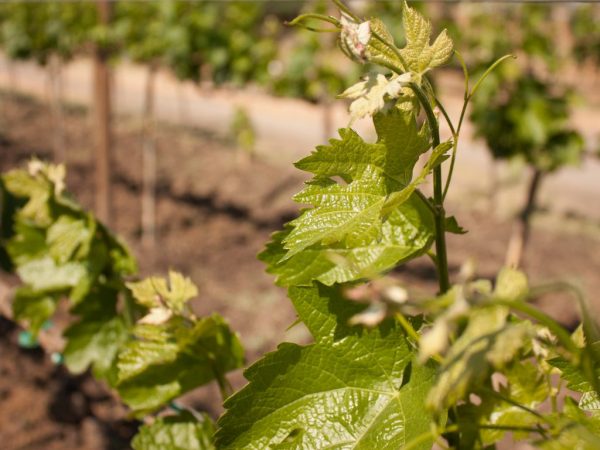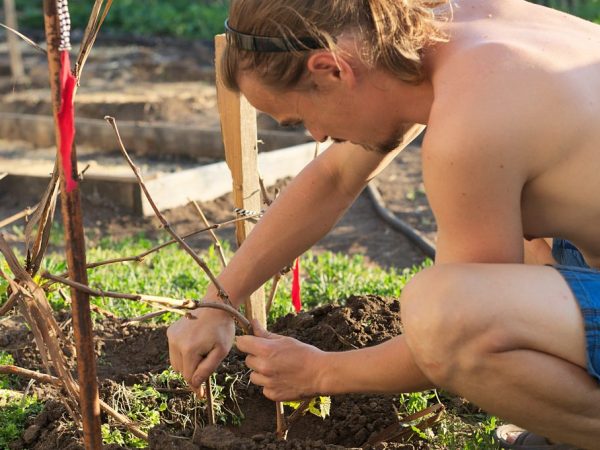Methods for propagating grapes by layering
Reproduction of grapes by layering will increase the area of the vineyard by increasing the number of grape bushes and includes several methods.
- The essence of reproduction by layering
- Advantages and features of the
- Features of the event in different seasons
- Underground method of propagation by layering
- Reproduction by perennial layering
- Reproduction by hilling a bush
- Propagation by air layers
- Reproduction in Chinese
- Reproduction by lignified shoots
- Conclusion

Methods for propagating grapes by layering
The essence of reproduction by layering
Grape layering - a stem split off from the mother bush, rooted after digging it in and acting as a seedling for subsequent reproduction. The direct relationship with the parent plant creates the most favorable conditions for its nutrition, active development and formation of the root system.
Reproduction by layering is one of the simplest methods that have proven themselves in the process of breeding difficult-to-root grape varieties.
At the same time, high rates of survival are recorded, especially in vineyards, where plants are not susceptible to diseases of the root system. A sufficient number of adventitious roots are formed on the vine shoots dug into the mother bush, which makes it possible for young seedlings to quickly take root.
Advantages and features of the
The advantages of this breeding method:
- allows you to reconstruct obsolete bushes,
- significantly increases the vineyard area in a short time,
- makes it possible to form bushes of an unusual shape, which is widely used in landscape design,
- preserves the properties of the parent bush,
- provides harvests in the first year after planting.
Features of the event in different seasons
Reproduction in summer begins when the length of the vine reaches 2.3-2.5 m. More often this period occurs in the last days of July-early August.
In the fall, the procedure is carried out, if necessary, to urgently obtain a seedling, while providing its shelter for the winter with material, the thickness of which is 20-25 cm.
The choice of method depends on the technology of planting and digging.
Underground method of propagation by layering

With the underground method, almost all shoots take root.
It is recommended to propagate grapes underground by choosing a strong mother bush with a high yield, which is located in a spacious place or near replacement bushes. Conducted in stages:
- In the spring, in the process of pruning, 2 young shoots are selected on the mother bush, which will then be laid in the ground. This is done closer to the ground.
- In summer, when the shoots reach a length of 2 m, trenches are dug around the mother bush to a depth and width of 0.5 m, making sheer walls and a bottom at an angle of 35-45 ° C with respect to the parent bush. About 10 kg of organic matter mixed with earth is laid out on the bottom and watered.
- Shoots-arcs are laid in the trenches, previously cleaned of foliage, stepsons and antennae. They are half covered with earth and tamped. Pour 20 liters of water.After it is completely absorbed, the soil is poured, bringing the top of the shoot to the surface so that the growth point is above ground level.
- The arches are watered after 4 days, during the summer by regular watering.
- In August, the tip of the branch is broken off, which prevents the growth of the ground part and redirects the flow of nutrients to the development of the adventitious root system.
- In September-October, the shoots are separated from the mother bush and placed in the winter for planting in the spring in a permanent place.
The main advantage of the underground method is a high survival rate and rooting rate.
Reproduction by perennial layering
For reproduction by perennial shoots, a perennial arm with young vines is rooting. For this purpose, a ditch is dug near the mother bush to a depth of 0.5 m and organic matter mixed with earth is introduced there. There are several ways to deepen the shoots:
- if you intend to get 1 seedling, 1 shoot is deepened, leaving a top with several eyes on the surface of the soil,
- if it is necessary to get several seedlings, all the vines are laid in a ditch, having previously cut off 3-4 eyes, pressed in several places with a wire.
As the vine grows, soil is poured into the ditch and watered. The sleeves are separated and transplanted from the parent bush in the fall.

Only healthy bushes are subject to propagation.
It will be possible to propagate grapes in this way only with the use of healthy and fruiting mother bushes that do not have wilted lower shoots and foliage at the ends.
Reproduction by hilling a bush
The grape propagation method by hilling the head of the bush is suitable for plants with compact form. It consists in the formation of layering due to the depletion of the parent bush.
When choosing propagation through hilling, it is important to constantly maintain moisture for the hilling bush, since shoots are able to form a root system only in a humid environment.
In the spring, when the processes grow at least 25 cm in length, they are shortened by 1-2 eyes. The grape bush is spud with moist, loose soil, creating a hill. In the fall, a soil mound is dug up, and the shoots are separated along with the root system formed in them.
Propagation by air layers
Reproduction of grapes by air layers consists in the formation of a bark system on a lignified process, for which:
- in the spring, a strong shoot is picked up, cleaned of foliage and, at a distance of 20 cm from the top, an annular cut 5 mm wide is made, wrapped in wet moss and tied with black polyethylene, roots will appear in this place,
- in the fall, the appearing processes are cut off and planted in pots, placing in a cool place.
With the air method, young shoots are transplanted in the spring to a permanent place in open ground.
Reproduction in Chinese
The Chinese method of grape layering makes it possible to obtain 10-20 seedlings in a short period of time. It includes:
- digging a trench in the spring to a depth of 0.25 m,
- laying a mixture of humus, superphosphate and potassium at the bottom of the trench,
- choosing a strong shoot on the mother bush, located closer to the ground and laying it in a trench with a clamp in 2-3 places with a wire,
- backfilling the laid shoot with soil and watering,
- removal of eyes on the remaining vine on top of the soil and wire hauling,
- separation of cuttings from the parent bush in the fall and their transplant.
The Chinese method allows for the propagation of difficult-to-root varietal varieties.
Reproduction by lignified shoots
The method of reproduction by lignified layers is used in the fall. It consists in the survival of young shoots through double nutrition. Among the minuses, it is noted that the grapes are completely separated from the parent bush no earlier than 3 years after the procedure.
The method includes:
- digging a hole near a bush to a depth of 0.6 m, introducing organic matter mixed with soil into it,
- laying the lowest shoot in a pit, leaving the top with 3 eyes above the ground surface.
New layers of grapes yield a harvest after the first year.
Conclusion
Propagation of grapes by layering allows you to quickly increase the grape area. It includes several methods, the choice of which depends on the purpose of the breeding process.


